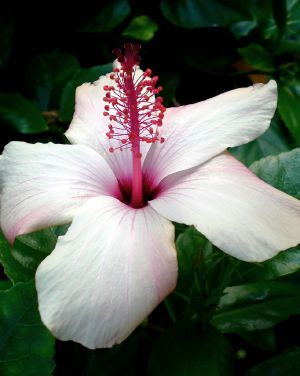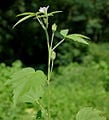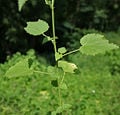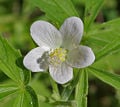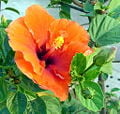Hibiscus
- For other uses, see Hibiscus (disambiguation).
| Hibiscus | ||||||||||||
|---|---|---|---|---|---|---|---|---|---|---|---|---|
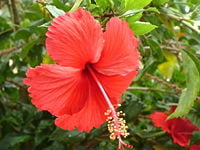 | ||||||||||||
| Scientific classification | ||||||||||||
| ||||||||||||
The Genus Hibiscus comprises plants also commonly called hibiscus and less widely known as rosemallow The large genus of about 200–220 species of flowering plants in the family Malvaceae (the mallow family, along with members like cocoa, cotton, okra, baobab and durian) native to warm, temperate, subtropical and tropical regions throughout the world. The genus includes both annual and perennial herbaceous plants, and woody shrubs and small trees.
Chrysanthemum is the common name and genus name for a group of erect, herbaceous perennial plants in the flowering plant family Asteraceae (aster, daisy or sunflower family), generally characterized by aromatic, deeply lobed, alternate
Overview and description
- Malvaceae, or the mallow family, is a family of flowering plants containing over 200 genera with close to 2,300 species.[1] The largest genera in terms of number of species include Hibiscus (300 species), Sterculia (250 species), Dombeya (225 species), Pavonia (200 species) and Sida
- Leaves are generally alternate, often palmately lobed or compound and palmately veined. The margin may be entire, but when dentate a vein ends at the tip of each tooth (malvoid teeth). Stipules are present. The stems contain mucous canals and often also mucous cavities. Hairs are common, and are most typically stellate. The flowers are commonly borne in definite or indefinite axillary inflorescences, which are often reduced to a single flower, but may also be cauliflorous, oppositifolious or terminal. They often bear supernumerary bracts. They can be unisexual or bisexual and are generally actinomorphic, often associated with conspicuous bracts, forming an epicalyx. They generally have five valvate sepals, most frequently basally connate. Five imbricate petals. The stamens are five to numerous, connate at least at their bases, but often forming a tube around the pistils. The pistils are composed of two to many connate carpels. The ovary is superior, with axial placentation. Capitate or lobed stigma. The flowers have nectaries made of many tightly packed glandular hairs, usually positioned on the sepals. Most often a loculicidal capsule, a schizocarp or nut.
The leaves are alternate, simple, ovate to lanceolate, often with a toothed or lobed margin. The flowers are large, conspicuous, trumpet-shaped, with five or more petals, ranging from white to pink, red, purple or yellow, and from 4-15 cm broad. The fruit is a dry five-lobed capsule, containing several seeds in each lobe, which are released when the capsule splits open at maturity.
Uses
(Hibiscus rosa-sinensis).
Many species are grown for their showy flowers or used as landscape shrubs. Hibiscus is also a primary ingredient in many herbal teas.
One species of Hibiscus, known as Kenaf (Hibiscus cannabinus), is extensively used in paper making. Another, roselle (Hibiscus sabdariffa) is used as a vegetable and to make herbal teas and jams (especially in the Caribbean).
In Mexico, the drink is known as Jamaican water or agua de Jamaica and is quite popular for its color, tanginess and mild flavor; once sugar is added, it tastes somewhat like cranberry juice. Dieters or persons with kidney problems often take it without adding sugar for its beneficial properties and as a natural diuretic. It is made by boiling the dehydrated flowers in water; once it is boiled, it is allowed to cool and drunk with ice.[1]
In Egypt and Sudan, roselle petals are used to make a tea named after the plant karkade.
Hibiscus species are used as food plants by the larvae of some Lepidoptera species including Chionodes hibiscella, Hypercompe hambletoni, the Nutmeg moth, and the Turnip Moth.
The Hibiscus is used as an offering to Goddess Kali and Lord Ganesha in Hindu worship. The Gumamela or Hibiscus rosa sinensis linn flower has antifungal, emmenagogue, emollient and refrigerant effect.[240]
The bark of the hibiscus contains strong fibers. They can be obtained by letting the stripped bark sit in the sea in order to let the organic material rot away. In Polynesia these fibers (fau, pūrau) are used for making grass skirts. They have also been known to be used to make wigs.
Hibiscus, especially white hibiscus, is considered to have medicinal properties in the Indian traditional system of medicine, Ayurveda. Roots make various concoctions believed to cure various ailments.
The natives of southern India use the Red hibiscus (Hibiscus rosa-sinensis) for hair care purposes. The red flower and leaves, extracts of which can be applied on hair to tackle hair-fall and dandruff on the scalp. It is used to make hair-protective oils. A simple application involves soaking the leaves and flowers in water and using a wet grinder to make a thick paste, and used as a natural shampoo.
In the Philippines, the gumamela (local name for hibiscus) is used by children as part of a bubble-making pastime. The flowers and leaves are crushed until the sticky juices come out. Hollow papaya stalks are then dipped into this and used as straws for blowing bubbles.
Dried hibiscus is edible, and is often a delicacy in Mexico.
The hibiscus flower is traditionally worn by Hawaiian women. A single flower is tucked behind the ear. Which ear is used indicates the wearer's availability for marriage.
National symbol
Hibiscus syriacus is the national flower of South Korea.
Hibiscus rosa-sinensis is the national flower (Bunga Raya) of Malaysia.
Care
Hibiscus flowers need to be taken care of in warm temperatures. They bloom best with temperatures ranging from 60 to 90 degrees Fahrenheit (15 to 30C). The hibiscus needs to be watered carefully. Make sure you do not overflood the roots. Keep a steady flow of water for the plant in warm weather. In colder weather, only water the plant if it looks dry. Hibiscus needs to be fed plant food. Try to keep all insects and pests away so the flower does not get ruined. If you are potting your flower, make sure the pot has plenty of drainage.
Species
In temperate zones, probably the most commonly grown ornamental species is Hibiscus syriacus, the common garden Hibiscus, also known in some areas as the "Rose of Althea" or "Rose of Sharon" (but not to be confused with the unrelated Hypericum calycinum, also called "Rose of Sharon"). In tropical and subtropical areas, the Chinese hibiscus (H. rosa-sinensis), with its many showy hybrids, is the most popular hibiscus.
About 200-220 species are known, including:
|
|
Gallery
Hibiscus rosa-sinensis in India.
External links
Credits
New World Encyclopedia writers and editors rewrote and completed the Wikipedia article in accordance with New World Encyclopedia standards. This article abides by terms of the Creative Commons CC-by-sa 3.0 License (CC-by-sa), which may be used and disseminated with proper attribution. Credit is due under the terms of this license that can reference both the New World Encyclopedia contributors and the selfless volunteer contributors of the Wikimedia Foundation. To cite this article click here for a list of acceptable citing formats.The history of earlier contributions by wikipedians is accessible to researchers here:
The history of this article since it was imported to New World Encyclopedia:
Note: Some restrictions may apply to use of individual images which are separately licensed.
- ↑ Judd & al.


